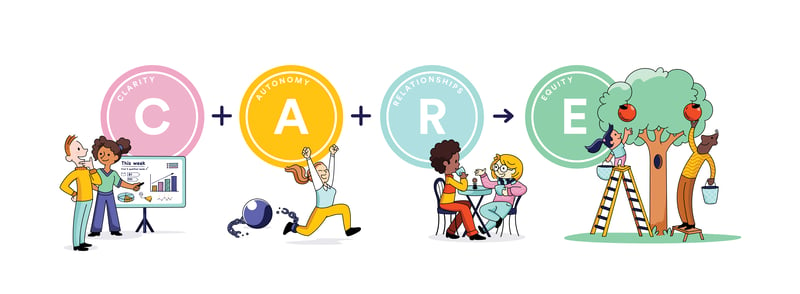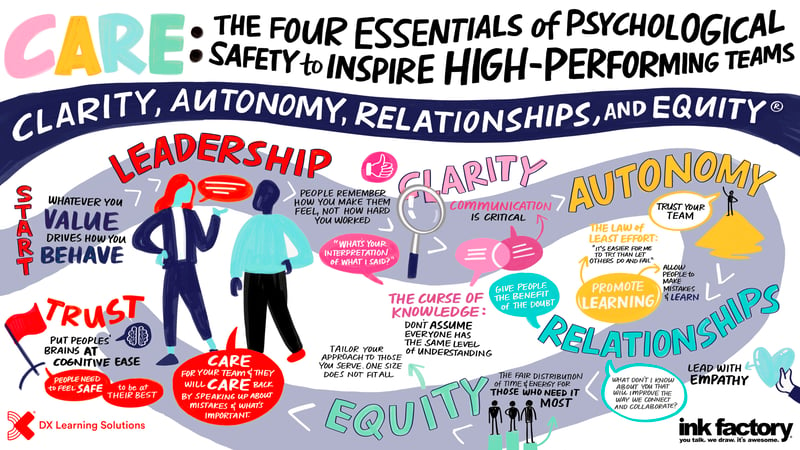Leading Hybrid Teams: Creating an Effective Working Model with CARE

The introduction of hybrid work teams truly marks the dawn of a new era in corporate America, ushering in a transformed way of working. As organizations transition to this novel model, it's crucial to recognize that new circumstances necessitate new best practices. The dynamic nature of hybrid work offers remarkable benefits, such as heightened productivity, improved employee well-being, and a harmonious work-life balance.
However, amid these gains, a significant challenge emerges – the potential erosion of employees' connection with the organizational culture. In this evolving paradigm, maintaining that crucial link demands deliberate strategic efforts.
Understanding the Hybrid Working Landscape
The hybrid work environment spotlights the emergence of distinct worker preferences. While some seek a clear boundary between personal and professional spheres (Splitters), an emerging cohort embraces a blended approach, allowing for flexibility in exchange for occasional longer hours (Blenders). Recognizing these preferences is pivotal for effective leadership in a hybrid environment.
Abraham Maslow's timeless question lingers: Why do organizations often design their structures around a presumption that employees evade responsibility? The answer lies in the tendency to cater to the lowest common denominator. This approach inadvertently neglects engaged, proactive employees, impacting their experience within the organization.
Research shows that 70% of employees' engagement correlates significantly with their experience under their manager's guidance (Gartner). The power of a manager's influence encompasses understanding team strengths, fostering individual growth, and making astute decisions about role distribution. This proactive approach not only attracts and retains top talent but also nurtures positive connections within the organization's fabric.
Leadership in the Hybrid Era
Amid the leadership challenges, the issue of trust within organizational leadership surfaces prominently. With only a mere 21% of employees firmly trusting their organization's leadership, a reimagining of trust-building strategies becomes vital.
The evolving landscape of hybrid work often results in microcultures within larger organizations. These microcultures, if aligned with the broader organizational vision, can prove harmonious. Leaders, acting as ambassadors and figureheads of these cultures, assume the crucial role of maintaining consistency while fostering autonomy.
Engagement begets engagement. A staggering statistic reveals that only one in three leaders is actively engaged. This disconnect emphasizes the need for deliberate efforts to invigorate leadership engagement, given its direct influence on team commitment.
Remarkably, less than 10% of leaders have received formal training or coaching in leading hybrid teams. This highlights a crucial gap that organizations must address to unleash their leaders' full potential in navigating this evolving landscape.
As we embark on this transformative journey of hybrid teams, it's clear that traditional leadership paradigms require recalibration. Embracing employee preferences, cultivating trust, and nurturing proactive engagement form the cornerstones of effective leadership in the hybrid era.
Crafting the Perfect Hybrid Work Model
In the absence of a clear path for leaders to accomplish this ambiguous utopian state, many leaders struggle to establish and maintain an effective work environment for this new working model. Here at DX, we have developed a leadership model (CARE) that transcends these working models, as it focuses on human needs rather than environmental ones. Let me show you how…

Clarity
"The single biggest problem in communication is the illusion that it has taken place." - George Bernard Shaw
In the realm of hybrid work, where dispersed teams are the norm, the significance of clear communication cannot be overstated. The flexibility offered by hybrid models and work-from-home days empowers individuals to shape their work around their life's responsibilities. However, this independence necessitates alignment and transparent goal-setting to ensure teams remain on the same page as they disperse to work autonomously.
As we examine the complexities of a hybrid work setup, it's evident that role clarity emerges as a formidable challenge. Operating in such a model can amplify these challenges, making it essential to address them head-on. Communicating "Who is responsible for What by When" is not enough. Your team needs to understand their role and the roles of your team and how they interact with one another. That level of clarity allows them to disperse but still be functional as a unit.
To ensure success, adopting a standard set of best practices becomes paramount. Launching the week with an alignment meeting where each team member outlines their weekly goals and plans facilitates a shared understanding of what the team is tackling that week. A mid-week check-in meeting further solidifies this understanding, identifying areas that require additional resources, calling for collaboration, and ensuring continuous alignment.
Despite the digital age and robust digital conferencing tools, the power of in-person interaction remains unmatched. Clarity and collaboration meetings, when possible, should occur face-to-face. Non-verbal cues in human communication are irreplaceable, enhancing understanding and camaraderie. After all, it is theorized that more than half of human communication is non-verbal.
A critical aspect of establishing a functional hybrid model is involving the team in crafting it. Research indicates that teams who collaboratively decide on their hybrid work schedule exhibit higher engagement and well-being scores. This approach contrasts starkly with organizations that unilaterally dictate schedules, which often result in lower employee engagement and increased burnout.
When crafting your hybrid work model, consider probing questions to tailor it effectively. Analyze what aspects of the job are best accomplished from home or the office, and when the team feels most connected to the organization's culture. Design your workflow around what makes sense for your team. Come together to align and collaborate and allow autonomy and freedom for the work that can be done independently. The most important part of crafting this is communication and clearly articulating goals.
Autonomy
"The best executive is the one who has sense enough to pick good men to do what he wants done, and self-restraint to keep from meddling with them while they do it." - Theodore Roosevelt
Leaders often grapple with how to gauge remote productivity, leading to potential micromanagement pitfalls. However, the essence of hybrid models lies in granting autonomy, transcending the need for constant physical oversight. You don’t need to constantly need to observe your team in order to determine if they are being effective in their role.
The allure of a hybrid work setup rests in its flexibility. Once goals are clearly communicated, the hallmark of effective leadership becomes trusting the team to chart their own course toward accomplishing it. Hybrid work's success isn't dependent on your team’s hourly productivity, but on the tangible outcomes that result from their work.
In a remote work context, building trust emerges as the cornerstone. While the urge to monitor remote workers might be strong, embracing a hybrid approach signifies a transition toward outcome-driven leadership. Rather than focusing on surveillance, leaders must champion the empowerment that autonomy brings, fortifying both productivity and employee satisfaction.
The delicate balance between autonomy and aligned expectations requires careful consideration. Onboarding into the hybrid model requires transparent communication about the rules governing this new work style. How flexible can work hours be? What's the protocol for reporting progress? How quickly should queries be addressed? These guidelines provide a scaffold for autonomy to flourish within well-defined boundaries.
Adhering to best practices reinforces this approach. Leaders should refrain from becoming overly intrusive. Instead, they should articulate objectives clearly and then empower their team members to navigate their tasks independently.
Hire the right people and get out of their way.
Regular check-ins remain important, but they should supplement self-initiated efforts rather than stifle them. Additionally, establishing and disseminating a comprehensive rulebook detailing the hybrid model's expectations is essential. This proactive measure brings structure to autonomy, cultivating an environment primed for success.
In the evolving landscape of hybrid work, leaders who embrace autonomy and prioritize trust stand as pioneers of a progressive paradigm. By celebrating self-direction, valuing results over constant supervision, and setting clear parameters, these leaders foster an ecosystem where productivity flourishes, and teams thrive.
Relationships
"The strength of the team is each individual member. The strength of each member is the team." - Phil Jackson
In the ever-evolving landscape of modern workplaces, the undeniable link between employee engagement and meaningful relationships has become increasingly apparent. According to recent research, a staggering 80% of employees who reported receiving valuable feedback within the past week exhibited high levels of engagement. This insight underscores the significance of regular touchpoints, where leaders engage in genuine conversations with their teams. It's the closest thing we have to a silver bullet for boosting employee engagement.
However, a mere 16% of employees noted that their last interaction with their manager held any real significance. This begs the question: How can we ensure that our conversations hold genuine meaning? The answer lies in a multi-faceted approach that nurtures collaboration, recognition, and a strengths-based mindset.
First and foremost, recognition and appreciation form the cornerstone of meaningful exchanges. Acknowledging recent accomplishments and contributions reaffirms an employee's value within the organization. Moreover, discussions centering around ongoing projects, goals, and priorities provide employees with a clear sense of purpose, aligning their efforts with the company's trajectory.
Timing matters, too. Research suggests that conversations ranging from 15 to 30 minutes hold the optimal duration for meaningful exchanges. The emphasis should be on frequent, succinct interactions that facilitate ongoing communication rather than sporadic lengthy talks.
A strengths-based approach further elevates the conversation's significance. Understanding each team member's unique skills and focusing on leveraging those strengths within their role fosters both engagement and personal growth.
In-person collaboration remains unparalleled in building connections but that may not be a viable option for some hybrid teams. By emphasizing collaboration spaces and creating hybrid functionalities for remote team members, companies can bridge the physical gap and prioritize face-to-face interactions. To extend inclusivity, it's crucial to organize events catering to remote and hybrid workers. Initiatives like the Donut Virtual Coffee Scheduler, Jackbox Games Happy Hour, and Virtual Movie Nights not only boost participation but also promote a sense of belonging.
To fortify these efforts, consider instituting special interest groups, virtual book clubs, and social well-being committees. These platforms encourage interactions that transcend work-related matters, nurturing interpersonal connections and enhancing overall job satisfaction.
In leading a hybrid team, cultivating interpersonal relationships takes on paramount significance. Beyond the digital divide, fostering genuine connections bridges geographical gaps, forging a unified and cohesive unit. Personal interactions enhance trust, communication, and empathy, essential for effective collaboration. Through intentional efforts, leaders can transcend virtual barriers, ensuring every team member feels valued and understood. These relationships bolster morale, inspire loyalty, and lay the foundation for a harmonious and high-performing hybrid team, capable of tackling challenges and achieving collective goals with unwavering solidarity.
Equity
"The best leaders are those who understand that their job is to create an environment where great people can flourish." - Simon Sinek
Leading a hybrid team presents an intricate challenge in ensuring equitable resource allocation while respecting the unique dynamics of remote and in-person employees. It's crucial to recognize that equity takes on a whole new dimension in this context. Are we treating all team members fairly, irrespective of their physical presence?
Communication, tailored to each hybrid worker's preferences, is a cornerstone. Understanding their work-from-home routines, preferred hours, and unique circumstances allows for a customized approach. Flexibility isn't just about giving it; it's about embracing it ourselves as leaders. Knowing that one team member values morning family time, while another prefers an early start, means adapting our leadership style to accommodate these diverse needs.
In a hybrid model, where personal lives intersect with workspaces, sensitivity is paramount. Some may have excellent internet, while others struggle with connectivity. Distractions at home can differ significantly. Balancing work hours with life's responsibilities varies for each individual. It's essential to foster an environment that respects these differences.
Listening is an invaluable asset. The best leaders are adept listeners. Actively understanding the concerns, preferences, and challenges faced by hybrid team members builds trust and inclusivity. It’s not just about hearing; it's about appreciating the nuances of their experiences, which leads to a stronger sense of belonging.
Equitable distribution of resources goes beyond tangible assets. It encompasses respect for individual lifestyles, acknowledging that everyone's situation is unique. As leaders, our role is to empower each team member to thrive within this hybrid work arrangement. Whether they're dialing in from a bustling home or a quiet office, they all contribute, and it's our responsibility to ensure their contributions are equally valued and supported.

Key Takeaways: Embracing the Hybrid Work Paradigm
In summary, leading a hybrid team isn't just about managing tasks; it's about understanding, respecting, and fostering an environment where everyone can flourish. By tailoring our approach, embracing flexibility, and actively listening, we not only ensure resource equity but also empower our team members to succeed in this new, dynamic workplace paradigm.
In the ever-evolving landscape of hybrid work, success hinges on the art of balance. Clear communication serves as the compass, guiding teams through digital and physical spaces seamlessly. Satisfaction blooms when autonomy is embraced, allowing individuals to flourish on their terms while staying aligned with collective goals. Yet, the heart of any hybrid team's triumph lies in the cultivation of interpersonal relationships—bridging gaps, nurturing trust, and creating a network of collaboration. Equitably allocating resources is the glue that holds this hybrid culture together. Ensuring all team members have what they need, from tangible assets to intangible support, underscores the principle of fairness that modern leadership demands.
Unlock the Full Potential of Your Hybrid Team with The CARE Experience®.
Insights

Subscribe to Our Monthly Newsletter!
For managers and talent professionals who truly believe in putting people first, the CARE to Win blog is your gateway to the latest insights on human-centric leadership. Join us as we champion the people first movement.
Need some time apart? Are we emailing you too often? Just give us your feedback, and we promise we’ll respond. We really do care. And if it’s still too much, just unsubscribe. It’s cool.
 Matt Sandel
Matt Sandel


